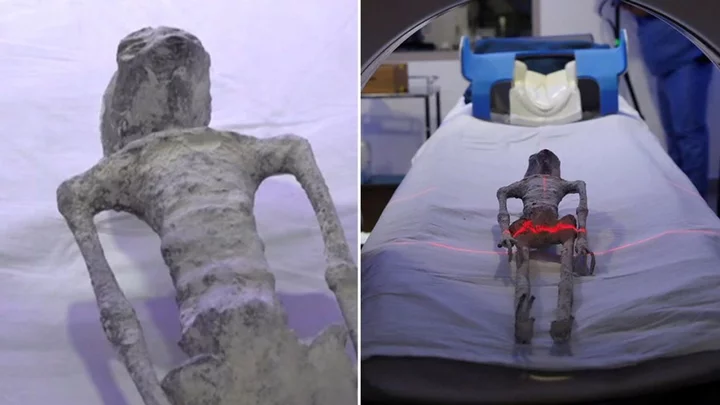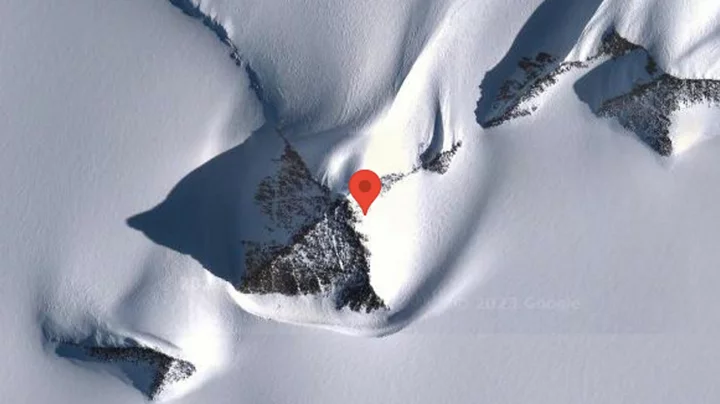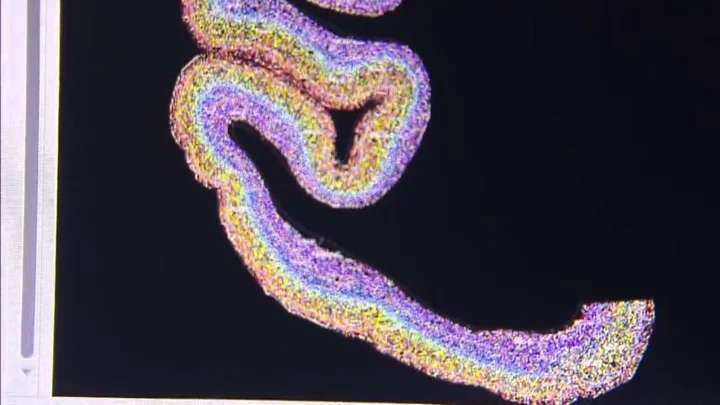
A scientist has discovered when Earth's first continent was formed
A researcher has figured out that the Earth’s first continent was formed 3bn years ago, in a new paper that sheds fresh light on the early stages of the planet’s life. Jane Greaves, an astronomy professor in the School of Physics and Astronomy at Cardiff University in Wales, was examining continent formation on distant stars and planets. It is thought that exoplanets with continents that formed in a similar way to Earth’s are more likely to be habitable, and perhaps even contain alien life. In the process, she calculated when several distant planets’ continents were born, as well as those a little closer to home. Continents on Earth sit on top of the planet’s hot, viscous mantle. Heat from the inner core stops the mantle from solidifying. The reason the core is hot is because it contains radioactive elements that came from neutron star collisions billions of years ago such as forms of Uranium, Thorium and Potassium. By analysing how many materials like this are present on Earth and on other planets, we are also able to estimate when the continents formed. On Earth, that was about 9.5 billion years since the beginning of the universe. Meanwhile, in Greaves' sample, the first continents appeared 2bn years before Earth’s on the exoplanets of younger, so-called thin disk stars. Older, thick disk stars analysed in her work produced rocky planets with continents that appeared even earlier: about 4 to 5bn years before Earth’s. “The outlook seems very promising for finding rocky exoplanets with continents, given that nearby Sun-like stars have already produced a few candidate hosts,” she wrote. The study, “When were the First Exocontinents?” is published in Research Notes of the American Astronomical SocietySign up to our free Indy100 weekly newsletter Have your say in our news democracy. Click the upvote icon at the top of the page to help raise this article through the indy100 rankings.
2023-09-21 17:19

Musk start-up Neuralink seeks people for brain-implant trial
The company hopes to help people with paralysis move a cursor, or type, using its brain implant.
2023-09-20 23:18

Scientists confirm that one of Mexican aliens is 'alive' after controversial research
Scientists in Mexico have given their verdict on the supposed 'aliens' that were presented to the country's congress last week. Much controversy existed around the aliens who were presented by a man named Jaime Maussan who has previously been accused of using the mummified beings, apparently found in Peru, as part of an elaborate hoax. Despite spawning dozens of memes, the aliens are apparently being treated seriously enough that they have now been studied by scientists who have said that the figures are ‘single skeletons’ and also have 'eggs' inside of them. The two aliens have been named Clara and Mauricio and have reportedly been studied in a lab at the Noor Clinic in Mexico. Lead researcher Dr Jose de Jesus Zalce Benitez, a former navy forensics doctor, who added that as well as being "a single skeleton" the aliens are also a "complete organic being." He also denied that the aliens were part of a hoax and even said that Clara was "alive, was intact, was biological and was in gestation." However, much like the alien bodies themselves, the research has been clouded in controversy and scepticism as the research has yet to be officially verified, with Nasa scientist Dr David Spergel questioning why the findings haven't been made public, as per the BBC. Spergel said: "He said: "If you have something strange, make samples available to the world scientific community and we'll see what's there." Benitez did add in his address at the press conference: "We are facing the paradigm of describing a new species or given the opportunity to accept that there has been contact with other beings, non-humans, that were drawn and marked in the past by diverse cultures throughout the world." Sign up for our free Indy100 weekly newsletter Have your say in our news democracy. Click the upvote icon at the top of the page to help raise this article through the indy100 rankings.
2023-09-20 16:23

Vatican comes to Nasa's aid in historic space mission
A Vatican astronomer has come to the help of NASA with a historic mission to study an asteroid. Meteorite expert and Vatican astronomer, Jesuit Brother Bob Macke, came to the aid of the US space agency after building a custom device that would allow the study of material of a sample collected from an asteroid. The mission is that of the unmanned spacecraft, Osiris-Rex, which was launched in 2016 in order to collect samples on an asteroid named Bennu. Bennu is located close to Earth and Osiris-Rex successfully collected a cup of material from the asteroid in 2020. Now, the vessel is approaching Earth and is due to release the sample in a return capsule on 24 September before continuing its orbit of the sun. Macke was contacted by the lead of the mission’s sample analysis working group, Andrew Ryan, who asked him to build the device that was needed in order to analyse the sample of the Bennu asteroid. The device has been devised so that it can analyse the density and porosity of the samples to help identify the make up of the asteroid surface. It is known as a pycnometer and NASA has strict requirements for the device, though other companies contacted were not willing to custom make one. Macke, however, took up the task and was able to build it in five weeks thanks to the assistance of students at the University of Arizona who collaborate with the Vatican Observatory’s advanced technology telescope in Tucson. In March it was delivered to the NASA Johnson Space Center in Houston for a test run and is hoped to be used for the real thing when the sample arrives from space. Sign up to our free Indy100 weekly newsletter Have your say in our news democracy. Click the upvote icon at the top of the page to help raise this article through the indy100 rankings.
2023-09-19 22:27

Mysterious 'pyramid' discovered in Antarctica beneath the ice
Conspiracy theorists have been turning their attention to Antarctica more than you’d expect over recent years. First, there was the case of the “bleeding waterfalls”, which remains one of the strangest natural phenomena you're likely to see, and there’s also the mystery of a so-called “pyramid” which has been found on the continent. Only, it’s not a pyramid at all – in fact, it’s a mountain. The Ellsworth Mountains are the highest mountain range in Antarctica and stretch 400km and the mountain in question was discovered by the British Antarctic Expedition of 1910-1913 It was called “The Pyramid” to keep the true nature of the discovery hidden from others at the time. Over the last hundred years, however, people have been speculating about the true nature of the location (even though it’s very much a mountain, poking up out of the ice) and now a second interesting geographical feature has bee discovered and got them talking all over again. The location in question is found at the coordinates 79°58’39.25?S 81°57’32.21?W, which has been a much-searched spot on Google Earth. Speaking to IFL Science, geologist at the German Research Centre for Geosciences in Potsdam, Dr Mitch Darcy, said: “The pyramid-shaped structures are located in the Ellsworth Mountains, which is a range more than 400 km long, so it’s no surprise there are rocky peaks cropping out above the ice. The peaks are clearly composed of rock, and it’s a coincidence that this particular peak has that shape. “It’s not a complicated shape, so it’s not a special coincidence either. By definition, it is a nunatak, which is simply a peak of rock sticking out above a glacier or an ice sheet. This one has the shape of a pyramid, but that doesn’t make it a human construction.” So, the new location is just that – a mountain poking out the top of the ice in Antarctica, and not a mysterious pyramid at all. Antarctica has been the subject of more than its fair share of speculation recently, after conspiracy theorist Eric Hecker described the Amundsen–Scott South Pole Station by the south pole as an “air traffic control” hub for aliens earlier this year. Hecker claimed that in 2010 Raytheon, the US aerospace and defence conglomerate chose him to be a contractor on the research centre operated by the United States National Science Foundation. There was “much more” to the station that first met the eye, according to Hecker. Sign up to our free Indy100 weekly newsletter Have your say in our news democracy. Click the upvote icon at the top of the page to help raise this article through the indy100 rankings.
2023-09-19 19:17

Strange 'mathematical pattern' found in the human bodies
The human body is a marvel of science and researchers have discovered a strange reoccurring mathematical pattern within its cells. Our bodies are made up of a massive variety of individual cells with countless different functions, from neurons in our nervous system to the oxygen carriers that all work in harmony to keep us alive. Experts from scientific research institutions in Germany, Canada, Spain, and the US have worked together on a study to determine just how many cells of each type there are in the human body and the results are staggering. They found that most adult males possess around 36 trillion cells, while adult females have in the region of 28 trillion cells. For a 10-year-old child, they have around 17 trillion. Interestingly though, scientists discovered that, regardless of the total number of cells, if they are grouped according to their function, the proportions for each individual remain the same. The researchers explained in their findings: “These patterns are suggestive of a whole-organism trade-off between cell size and count and imply the existence of cell-size homeostasis across cell types.” Scientists believe there is a natural balancing act at play between different cell types with new cells being produced to maintain the balance. The body produces fewer larger cells (such as muscle fibres) and more smaller cells (like blood cells). It is hoped that future studies will be able to uncover exactly how this happens and how bodies seem to naturally regulate cells. They explained that all cells are perfectly sized for their roles and any deviation from their scale can indicate the presence of disease. Experts have made their data, analysis and results public in the hopes that future studies into biology will be able to utilise their research. Sign up to our free Indy100 weekly newsletter Have your say in our news democracy. Click the upvote icon at the top of the page to help raise this article through the indy100 rankings.
2023-09-19 18:58

Biden Policies Drive Smart Bets on Green Technology, Brainard Says
An array of US government tax credits, loan guarantees and research are unlocking billions in private sector investments
2023-09-19 18:53

Scientists have discovered a new fly that fails its one job
Scientist have discovered a fly that... can't fly. In December 2021, the John Midgley and Burgert Muller from the Diversity of Pollinating Diptera in South African Biodiversity Hotspots project went to Lesotho, the only country in the world that has its entire territory located at an altitude of 1,000 metres and higher to see what they could find. At the Afriski mountain resort, they found 51 male specimens of Atherimorpha latipennis (a species discovered in 1956 but whose female had never been described) and a for the first time a female belonging to the same species which couldn't get off the ground. “It’s not unheard of for only the female of a species to be flightless,” says Midgley. “But there were no examples in this fly’s family, let alone its genus.” Martin Hauser, a senior dipterologist at the California Department of Food and Agriculture, who was not involved in the research, told the Guardian: “Active flight has only originated four times in the last three billion years, so it’s always interesting when a species loses the ability to fly. It isn’t super surprising to find flightless species. But it is remarkable when the first case of flightlessness is reported in a family.” Scientists could only make educated guesses about why the female had lost the ability to fly. Despite it being much faster than walking, allowing flies to escape predators. “flight is also costly,” said Midgley. “You have to grow wings, and it uses a lot more energy than walking.” “For the males it is worth flying around and being able to search a larger area for females,” said Hauser. “Even if, while flying, they are exposed to birds and other predators, and risk being blown off the mountain and ending up in a hot valley with no females.” Meanwhile, there are other species that can't fly like ostriches, kiwi and emus. It is thought they evolved to lose flight after the dinosaurs became extinct because there were no predators big enough to hunt them. Fly - you had one job... Sign up to our free Indy100 weekly newsletter Have your say in our news democracy. Click the upvote icon at the top of the page to help raise this article through the indy100 rankings.
2023-09-18 19:28

Man who stayed awake for 11 straight days shares how his brain ‘broke down’
A man who stayed awake for 11 straight days to set a world record has spoken about how he experienced his brain starting to ‘break down’. Englishman Tony Wright went an incredible 266 hours without sleep back in 2007 and set a new record – only to see it broken by someone else just a month later. Wright spoke about his experience in a clip posted by the YouTube channel Sleep Gods, saying that an entirely different part of his brain was activated during his record attempt. "Basically, you're starving the rational mind, the egotistical mind of sleep, and it's battery is running down. And of course, it doesn't feel very good, it feels tired. Wright added: "But if you push beyond that, its ability to stay in charge starts to break down as well. And that's where you can start to get glimpses of access to the other side of the brain, the other self." Man Who Didn't Sleep For 11 Days Explains Sleep Deprivation www.youtube.com "I've spoken to a lot of people about this. Most people have recollections where they've been partying, or they've been working hard, and sure they get tired, but within that they get glimpses of something else.” He went on to say: "That kind of softness, or a more relaxed state - often more emotional, because again, there's more access to that emotional side of the brain. "Even feeling quite good, quite an altered state for brief windows, or getting a second wind even. You know, be really, really tired, no sleep, and then suddenly feeling fine for half an hour or an hour. "So all I really did, or what I was interested in, is making sense of that. And is it possible to exploit that and bring in combining techniques to tie the left side of the brain up, which initially doesn't feel great, but the reward on the other side of that makes it worth the effort." Sign up for our free Indy100 weekly newsletter Have your say in our news democracy. Click the upvote icon at the top of the page to help raise this article through the indy100 rankings
2023-09-17 19:56

Video of GoFast UFO resurfaces after being mentioned in NASA report
NASA lifted the lid on its unidentified anomalous phenomena study on Thursday (14 September) which aimed to identify "how data gathered by civilian government entities, commercial data, and data from other sources can potentially be analysed to shed light on UAPs." While the report was "not a review or assessment of previous unidentifiable observations," the briefing prompted a video of 'GoFast UFO' to resurface. The clip from 2014 was released by the pilots "to clear up any misconceptions by the public on whether or not the footage that has been circulating was real or whether or not there is more to the videos." The statement on the Department of Defense further went on to say at the time: "After a thorough review, the department has determined that the authorized release of these unclassified videos does not reveal any sensitive capabilities or systems, and does not impinge on any subsequent investigations of military air space incursions by unidentified aerial phenomena." The clip also got a mention in the recent 36-page report, published on the NASA website. "A well-known UAP event is the “GoFast” video, recorded by navy aviators from the USS Theodore Roosevelt," it read. @uapbrand GOFAST UAP - better known as the 'Tic Tac' UFO. ? #UAP #UnidentifiedAerialPhenomena #UAPs #OVNI #OVNIs #UFO #UFOs #UFOvideo #UFOvideos "A still frame from this video is shown in the Figure below, where the infrared camera has locked onto a small object in the center. The video gives an impression of an object skimming above the ocean at a great velocity. But analysis of the numerical information on the display reveals a less extraordinary interpretation." Elsewhere, while the report disclaimed the galaxy "does not stop at the outskirts of the solar system," it stressed there is "no reason to conclude" that UFO sightings are alien. "Many of NASA's science missions are, at least in part, focused on answering the question of whether life exists beyond Earth," it read. "Those investigations include missions looking for biosignatures, perhaps on Mars or the icy moons orbiting Jupiter and Saturn - as well as farther afield, in the ratios of molecules present in exoplanet atmospheres. "Searching for signs of alien technology is a natural extension of those investigations." It added: "If we recognise the plausibility of any of these, then we should recognise that all are at least plausible." Sign up for our free Indy100 weekly newsletter Have your say in our news democracy. Click the upvote icon at the top of the page to help raise this article through the indy100 rankings.
2023-09-15 16:57

Scientists have discovered a fly that can't fly
Scientist have discovered a fly that... can't fly. In December 2021, the John Midgley and Burgert Muller from the Diversity of Pollinating Diptera in South African Biodiversity Hotspots project went to Lesotho, the only country in the world that has its entire territory located at an altitude of 1,000 metres and higher to see what they could find. At the Afriski mountain resort, they found 51 male specimens of Atherimorpha latipennis (a species discovered in 1956 but whose female had never been described) and a for the first time a female belonging to the same species which couldn't get off the ground. “It’s not unheard of for only the female of a species to be flightless,” says Midgley. “But there were no examples in this fly’s family, let alone its genus.” Martin Hauser, a senior dipterologist at the California Department of Food and Agriculture, who was not involved in the research, told the Guardian: “Active flight has only originated four times in the last three billion years, so it’s always interesting when a species loses the ability to fly. It isn’t super surprising to find flightless species. But it is remarkable when the first case of flightlessness is reported in a family.” Scientists could only make educated guesses about why the female had lost the ability to fly. Despite it being much faster than walking, allowing flies to escape predators. “flight is also costly,” said Midgley. “You have to grow wings, and it uses a lot more energy than walking.” “For the males it is worth flying around and being able to search a larger area for females,” said Hauser. “Even if, while flying, they are exposed to birds and other predators, and risk being blown off the mountain and ending up in a hot valley with no females.” Meanwhile, there are other species that can't fly like ostriches, kiwi and emus. It is thought they evolved to lose flight after the dinosaurs became extinct because there were no predators big enough to hunt them. Fly - you had one job... Sign up to our free Indy100 weekly newsletter Have your say in our news democracy. Click the upvote icon at the top of the page to help raise this article through the indy100 rankings.
2023-09-15 16:28

5 things we learned from Nasa's report on UFOs
NASA has released details from its unidentified anomalous phenomena (a term to describe UFOs that can't be identified) study. When the study started a year ago, NASA set out to identify "how data gathered by civilian government entities, commercial data, and data from other sources can potentially be analysed to shed light on UAPs." They went on to highlight that Thursday's report (14 September) "is not a review or assessment of previous unidentifiable observations." Here are five major things we learned from the 36-page report: NASA should be more proactive when it comes to UFOs The report suggests that the space agency should use better techniques and vices when searching for UAPs. They said the current UAP detection is "often serendipitous," and captured by sensors "that were not designed or calibrated for this purpose, and which lack comprehensive metadata." This means the origin of several UAPs "remain uncertain". "The importance of detecting UAP with multiple, well-calibrated sensors is thus paramount, and accordingly we recommend that Nasa leverage its considerable expertise in this domain to potentially utilize multispectral or hyperspectral data as part of a rigorous data acquisition campaign," they wrote. Many 'credible witnesses' have reported UFOs The report revealed that many "credible" reports of "objects they did not recognise over US airspace" have come through from witnesses, "often military aviators". "Most of these events have since been explained, but a small handful cannot be immediately identified as known human-made or natural phenomena," it read. It noted that one of the problems when it comes to such sightings is that "the data needed to explain these anomalous sightings often do not exist." They added: "This includes eyewitness reports, which on their own can be interesting and compelling, but are not reproducible and usually lack the information needed to make any definitive conclusions." 'No reason to conclude' UFOs are alien While the report disclaimed the galaxy "does not stop at the outskirts of the solar system," it stressed there is "no reason to conclude" that UFO sightings are alien. "Many of NASA's science missions are, at least in part, focused on answering the question of whether life exists beyond Earth," it read. "Those investigations include missions looking for biosignatures, perhaps on Mars or the icy moons orbiting Jupiter and Saturn - as well as farther afield, in the ratios of molecules present in exoplanet atmospheres. "Searching for signs of alien technology is a natural extension of those investigations." It adds: "If we recognise the plausibility of any of these, then we should recognise that all are at least plausible." Satellites could potentially be used in the search for aliens "NASA is in an excellent position to contribute to UAP studies within the broader whole-of-government framework," they wrote, going on to explore the potential role of the "US commercial remote-sensing industry" which they say "offers a potent mix of Earth-observing satellites that offer imagery at sub- to several-meter spatial resolution, which is well-matched to the typical spatial scales of known UAP [UFOs]". They continued: "Such commercial constellations could offer a powerful complement to the detection and study of UAP when coincident collection occurs." Artificial intelligence could also help the hunt for aliens "The panel finds that artificial intelligence (AI) and machine learning (ML) are essential tools for identifying rare occurrences, potentially including UAP, within vast datasets," they wrote. "However, these powerful techniques will only work on well-characterized data gathered with respect to strong standards." They went on to note that the public "is also a critical aspect of understanding UAP". There's a lot more to learn "The top takeaway from the study is that there is a lot more to learn," NASA Administrator Bill Nelson said while releasing the report. "The NASA independent study team did not find any evidence that UAP have an extraterrestrial origin, but we don't know what these UAP are." Sign up for our free Indy100 weekly newsletter Have your say in our news democracy. Click the upvote icon at the top of the page to help raise this article through the indy100 rankings.
2023-09-15 00:15
